The last year and a half was jammed with so many hikes that It’s been quite a gap between gear reviews for me. This gear review will cover the gear I used for ~11 months of thru-hiking on a wide range of trails. The gear I used in 2016/2017 took me through the Sierra High Route, High Sierra Trail, Wind River High Route, Kings Canyon High Basin Route, and Wonderland Trail in the US. The Larapinta Trail, Bibbulmun Track, Coast to Coast Track, and Tasmania in Australia. The Te Araroa and more in New Zealand. The Haute Route Pyrenees and GR5 (French Alps) in France, and Switzerland’s Haute Route. Almost none of my gear needed replacing in those 11 months, and little changed from hike to hike. Unless I was in need of an ice axe, micros, or a bear canister my Base Pack Weight was just under 13lbs. Not ultralight, but definitely a comfortable zone for lightweight backpacking.
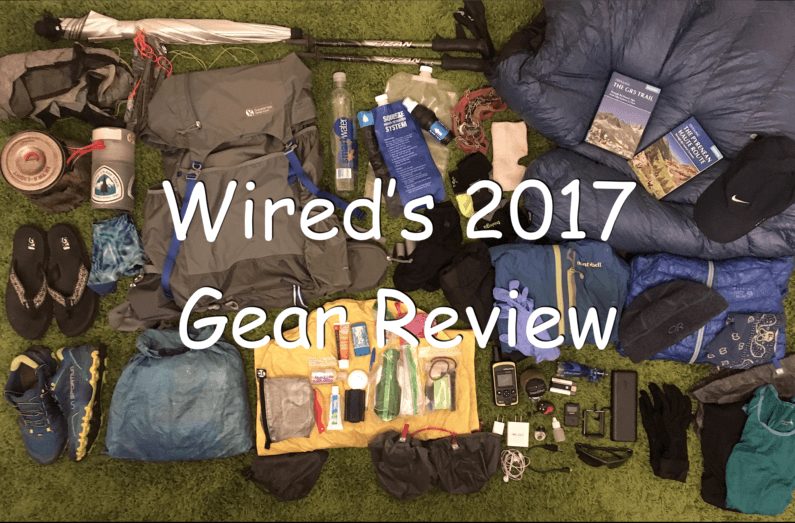
**For a complete list of my evolution of gear, gear reviews, and current gear with prices and weights, you can go to my GEAR TAB.
I want to give a big THANK YOU to Gossamer Gear, Sawyer Products, Trail Designs, StickPic, and Dirty Girl Gaiters for supporting me. As my followers know, I am not a walking commercial for gear. I use the gear that works best for me, not just what I can get for free. These are some reputable lightweight companies with really great gear. I’m grateful to represent them and their gear on the trail. THANK YOU!!!!
I’ve attached links to each piece so you can easily click and find it online. I do want to say that gear preferences are a very personal thing and that everyone needs to find what fits them the best. Just because I use it doesn’t mean it’s guaranteed to work for others. There’s a great variety out there and this is what has worked for me.
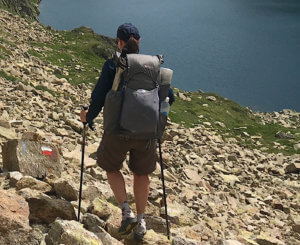 Gossamer Gear Mariposa(1lb 14.7oz)
Gossamer Gear Mariposa(1lb 14.7oz)
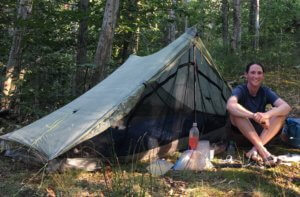 ZPacks Solplex (1lb .2oz, including 8 titanium stakes) Pros: Light and spacious! No tent is perfect, but it has become my favorite tent for a few reasons. A full bathtub floor and storm doors to make it fully enclosed. No need for a groundsheet so that saves weight too. I love the space and the full side door with the option to leave the storm doors open (even in a light rain). I’ve used a Solplex since 2014. It is guaranteed for one thru-hike (~150 days), but I’m able to get 250-300 nights out of each of mine.
ZPacks Solplex (1lb .2oz, including 8 titanium stakes) Pros: Light and spacious! No tent is perfect, but it has become my favorite tent for a few reasons. A full bathtub floor and storm doors to make it fully enclosed. No need for a groundsheet so that saves weight too. I love the space and the full side door with the option to leave the storm doors open (even in a light rain). I’ve used a Solplex since 2014. It is guaranteed for one thru-hike (~150 days), but I’m able to get 250-300 nights out of each of mine.
Bottom Line: If you have the $$ and want to save weight, this is the tent to get. A very close second for me is the Tarptent Protrail.
Pros: Very light and compact. I’ve used a ZPacks Bag since 2013. Although their temperature ratings are said to be exaggerated, I found it to be sufficiently warm. I often would just use it as a blanket and not need to fully zip it. However, it was quite cold at night on the trails I did this summer, so it was great! I’ve had this bag for three seasons, and over 300 nights. It may have lost some loft over the years, but it was still great and I plan to use as is next year too. Just heavenly!
This past year, I took a major step in simplification by choosing to use my iPhone SE as my sole camera. I used to use a Panasonic Lumix. Having one less piece of gear saved me $300/yr (I tend to break nice things) and 8oz of pack weight (that I then could put into the luxury of bigger battery). As a blogger, I like the ease of having my photos on my phone without needing to transfer them from an external camera. I’m not a pro at photography, and don’t know how to use the manual settings, so I’ve even found that my photos are often better with the advances of smartphones. As you can see, I also use a StickPic and phone adapter that attaches to my hiking pole for selfies and videos that show more of my surroundings. I also changed to a Pedco Ultra-pod Tripod that is easy to manipulate and also attaches to things with a velcro strap to allow for more versatility. I love this setup!
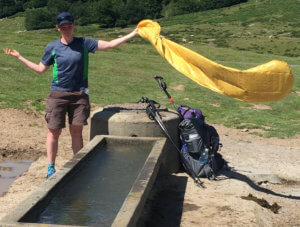
Finding the mystery hole on the trail.
Therm-a-Rest NeoAir XLite Women’s Sleeping Pad
Pros: Quite possibly my favorite piece of gear! Allowed me sink into the comfort of a bed every night. Light and compact. The XLite Women’s (men love it too!) is warmer, lighter, shorter, and more tapered . Also, there is a reflective layer within the pad that reflects body warmth back to the person laying on it. Really amazingly warm!
Pros: I was a skeptic and didn’t start using an umbrella until my third thru-hike. Now, I don’t want to leave home without it. With it, I often can avoid sweating in a rain jacket, my core stays dry, I didn’t have to put away my electronics, and I could take pictures as I please. I found a way to strap it to pack so it can be used hands free and love it! As a bonus use, I’ve found it useful in my tent as extra warm and protection from wind and rain when I open it up and prop it up in the vesibule of my tent. It does not replace rain gear, but is a great first line of defense. Especially for someone like me that can get cold quick in wet rain gear.
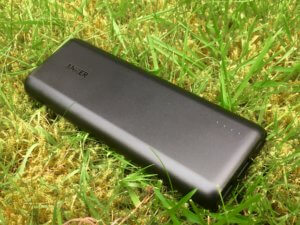 Anker PowerCore 20,100mAh Battery (12.6oz)
Anker PowerCore 20,100mAh Battery (12.6oz)
Trail Designs Caldera Cone Windscreen and Carrier
Pros: Light, efficient, simple, and sturdy. I’m a big fan of this setup and the windscreen. I have used it since I started thru hiking.
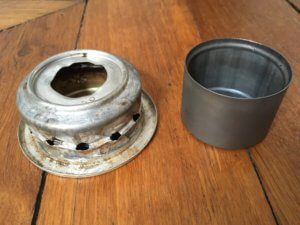
Caldera and Toaks Stoves
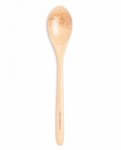
Bottom Line: It’s the best option out there for a light and efficient filter! Note, for even more protection (yet heavier), Sawyer has come out with a whole new line level of filters this year. Check them out!
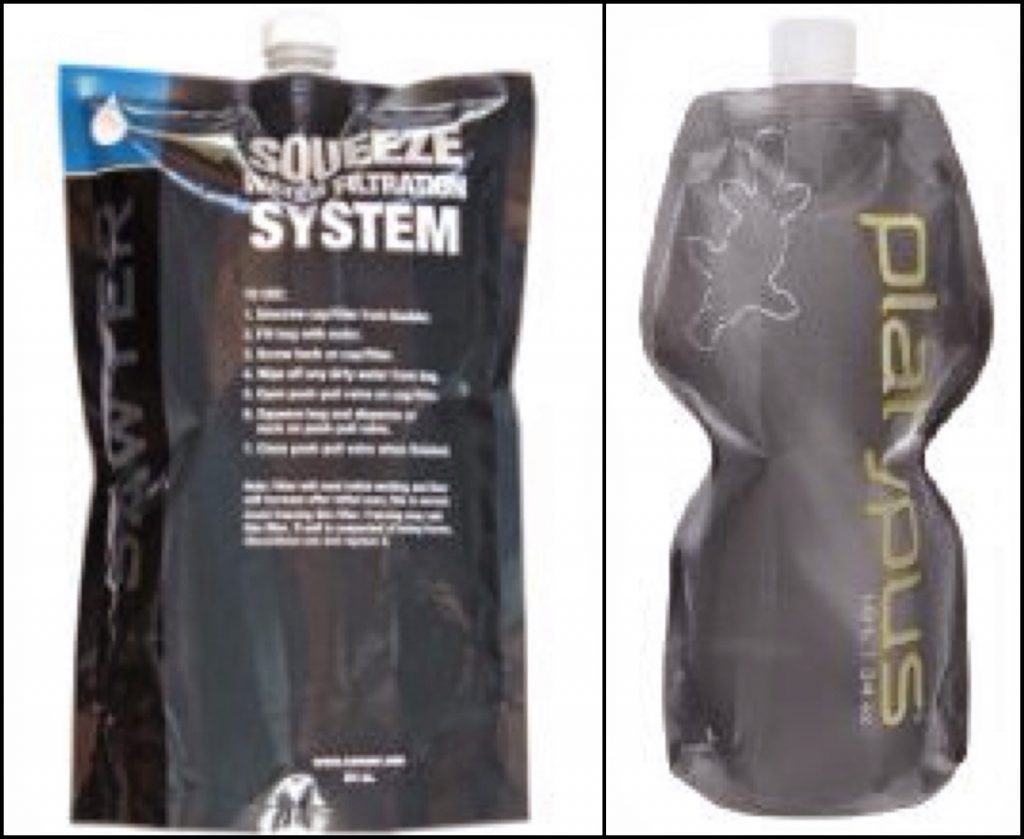 Sawyer and Platypus Water Bladders
Sawyer and Platypus Water Bladders
Pros: Light and collapsible. I preferred the Platypus bags because the are slightly more durable and clear so I can see the contents.
Cons: All bags used for squeezing eventually break at the seal where the bag connects to the mouth, but they did last half the hike this time. The Platypus bladders are sturdier, but the threads can be less adaptable to the Sawyer Squeeze and strip over time. Both bags will wear over time, and the Sawyer ones have a shorter lifespan. I know ahead of time this wear and tear will happen, so I have new ones in my bounce box. I have found the Platypus bladders are also easier to tape up when they get a hole. I actually would recommend the Evernew Bags that can be tough to get online. I just forget each year to do that and grab the Platypus at the last minute.
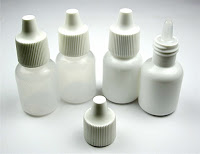
Gossamer Gear Ultralight Mini Dropper (0.2oz)
I carry one little dropper of bleach for treating water if I need to save time or for emergencies if I lose/break my filter. I put in two drops per liter and let it mix for 20mins before I drink. This used to be my main purification until I decided it might not be good on my stomach in the long run.
Sandisk iXpand Flash Drive(64GB) (1.1oz)
Pros: It’s a flash drive that works with an iPhone. This drive functions as my external hard drive. It can hold maps, guidebooks, data sheets, songs, movies, photos, etc. It is 64GB worth of storage and it plugs into the charging port of the iPhone to be able to view or download whatever you like from one device to the next. There is an iXpand app that’s free that it runs through. It has a USB port so you load it and can transfer data also just like a regular flash drive. Sooo worth the 1.1oz addition to my pack weight! I know many of you will cringe at this, but I loved using it for movies and shows that I’ve downloaded to watch in my tent at night or during some downtime.
Cons: It does require charging through a USB port. When using it to watch movies on the iPhone, it plugs into the charging port, so you cannot charge while using the device. It’s easier just to download from the drive to the phone and then watch so you can simultaneously charge. There were a few times a map file was too large to open on the iPhone. I don’t know if that was an app limitation or and iPhone limitation. If using a case, you may need to remove it to fit the prong in the lightning port.
Sandisk Sansa Clip MP3 Player (1oz)
Pros: She Sansa Clip has always been one of my favorite pieces of gear. It would greatly impact my hike if I didn’t have this little guy. Held all my songs and audiobooks easily. Also, small and clips to clothes or pack for easy use. Even takes mini sd cards so people were able to send me more songs and audiobooks. Saves me the battery usage on my phone. Usually less than $50, so easy to replace for someone like me that tend to lose or break things often.
Cons: Doesn’t hold as many songs as more expensive players unless you buy a mini sd to put in it. I keep a file of all my songs on my SanDisk Flash Drive to pull into it if I lose or break it and have to get a new one since it isn’t stored online like iTunes. The power button can be depressed in the pack without knowing it, and run the battery down. Big annoyance…
StickPic (.8oz)
I’ve had a lot of people ask how I shoot my selfies and videos while I walk. I use the awesome StickPic. It allows you to attach your camera to the end of your hiking pole for both pictures and video. Love it! You can order it online. Careful, they are easy to lose, so I recommend putting it on a carabiner. Also, if you lose the nut that tightens it to your camera, you can use medical tape on the screw and it tightens just fine. I have the adapter they also sell that holds your phone.
 Gossamer Gear Stuff Sacks (0.3-0.7oz)
Gossamer Gear Stuff Sacks (0.3-0.7oz)
Pros: With how much I can lose gear, I’m a stuff sack fan. I was skeptical at first, but they worked out great and were incredibly light.
Cons: It would be nice to have different colors. Each size has a different colored drawstring, but they are slightly sheer enough to know which is which. Careful with sharp things that could puncture them.
Sawyer Stay Put Sunscreen 30 & 50 SPF
I am very pale and require a lot of sunscreen. I’m used to sweating the sunscreen off and reapplying it every couple of hours, but then I finally used the Sawyer Stay Put Sunscreen! It is awesome! I used the 50SPF in the very strong sun of New Zealand and was totally fine. I carried the 8oz bottles for the long legs, but most could get away with just the small tubes that would last me a couple weeks. It is pricier than most sunscreens, but that is because just a little bit goes a long way. I always reapply halfway though the day, but I’m pretty sure it isn’t necessary. Sawyer’s site has great detailed videos on their products and how to use them. This is a highly reputable company and product. You can find it at REI, so I really recommend you give it a try and read/watch more about it.
Sawyer Picaridin Insect Repellent
I have always been paranoid about using Deet and the effects it can have. Sawyer uses Picaridin and I felt much better using it! I like that it comes in these small spray bottles basically the size of a marker. Again, Sawyer is a company that puts out quality products. They have detailed information on their technology and reasoning for the ingredients that they use and I recommend giving it a look to learn more about the quality of their products. They have a variety of insect repellents including lotions, so check it out.
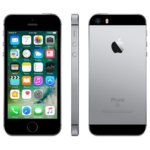
iPhoneSE (4oz)
Pros: Amazing to me such a little thing can do so much! Service is best with Verizon. It was my own personal computer, phone, camera, alarm clock, and GPS all in one. I love being able to Skype or FaceTime family or friends. If I’m hiking with another iPhone user, we can airdrop photos to one another without any service needed. Of course watching TV in my tent is a great plus! Just amazing, love it!
Cons: It can drain quickly using the GPS.
DeLorme (Now Garmin) inReach SE Satellite Messenger (6.7oz)
Pros: Leaving home without my inReach would be like not wearing a seat belt in my mind. The inReach allows you to text message or send coordinate tracks from just about anywhere. It uses the Iridium satellite system, which has worked for me all over the world. I can’t say enough about this device More detailed product reviews are out there and comparisons to the next level up, the inReach Explorer, so my review is that IT WORKS! I liked knowing my messages or waypoints were received as it gave me notice when it was. Also, being able to communicate with someone in civilization for emergencies is gold. I found I was using it for arranging times for hitches or having my family order gear for me to get in town. It was also great when the person I was communicating with had one too. Then we both could communicate where phones wouldn’t have service. Another great thing is that it can give you a weather report from anywhere you are. Great battery life! Has a built in battery and I could just charge that in town, but it really does take a long time for the battery to go down if you are just using it to check in at night. You can pair it to your smartphone via the internal Bluetooth on each device and then you can text like you normally would rather than using the clunky keys on the inReach. There are sliding scales for subscriptions depending on the level you will be using it.
Cons: It is heavier than most other PLBs. Garmin has now taken over production, and they are heavier than this model. It isn’t cheap, but well worth it! I will note that one catch is that if you want it to work with a public Trackleaders map like I have embedded on my site, you will need to send out a track point, and my subscription has that at 10 cents/track, which is reasonable. The screen is small, so I never used it as a GPS, but I’ve heard it isn’t ideal. The keys are archaic, clunky, and time consuming if you are trying to type a message, so I paired it by Bluetooth to my iPhone and texted that way.
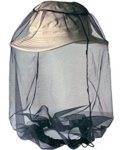 Sea to Summit Insect Shield Head Net (1.3oz)
Sea to Summit Insect Shield Head Net (1.3oz)
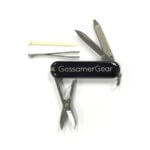
Gossamer Gear Backpacking Pocket Knife (.8oz)
Pros: Small, light, has multiple tools (including scissors!). The knife is even quite sharp.
Cons: Could be considered by some to be a luxury item that just adds extra weight…but those were the same hikers who have borrowed mine many times!
Cons: Added weight and took up space in my pack. Didn’t charge as fast as directly plugging one USB into a socket because it splits the charge.
Bottom Line: It’s a luxury item, but one I use frequently!
 Deuce of Spades Backpacking Trowel (.6oz)
Deuce of Spades Backpacking Trowel (.6oz)
Pros: Light and purposeful.
Cons: If it’s a hard packed rocky area or desert terrain, this may not be as effective as a hiking pole or a more sturdy trowel for digging cat holes.
Montbell Torrent Flier Rain Jacket (8oz) *No longer in production for women.
Pros: I used the same Montbell Torrent Flier rain jacket the last three summers with decent amounts of rain, and it’s been amazing! My lighter rain jackets lasted one or maybe two seasons, and the Torrent Flier easily lasted three. I used to carry the lighter OR Helium II, which is sufficient for the US Triple Crown Trails, but for trails with heavier colder rain, I love this jacket. I liked having the pit zips and the chest pocket is a must have for me in a rain jacket. It did a good job of keeping my phone and maps dry. I completely recommend this as a heavier duty rain jacket.
Con: Montbell seems to have stopped production (at this moment) on the women’s torrent flier. I will likely replace it this coming season with another Montbell jacket that is comparable once I see what they come out with in the spring.
Mountain Hardwear Ghost Whisperer Jacket (7.2oz)
Pros: I’ve used the Ghost Whisperer since 2013. Small, light, compact, warm, resilient, great! I think it is the lightest down jacket on the market. Made for a great pillow at night too!
Cons: Expensive. It does the trick while hiking, but it is down and needs to kept dry. It’s not for extended time in below freezing temps, but has been sufficient for me, especially when paired with my rain jacket for added warmth.
Bottom Line: The Ghost Whisperer has served me well, but with recent innovations, there are possibly synthetic options now that are comparable in weight and warmth. I may be switching to a synthetic option so I don’t have to worry as much about getting it wet or sweating in it.
Balega Socks (1.2oz)
I love these socks. They are just basic running socks, but as a runner, that’s what I’m most comfortable wearing. My feet have bad reactions to wool and these were great. They don’t last as long as thicker socks, but I stretch them as long as I can and have them in my resupplies.
Seirus Hyperlite All-Weather Gloves (1.8oz)
I really liked these gloves! No gloves are truly waterproof, so I suggest getting a pack of Nitrile gloves to wear over the gloves in the rain or in the mornings when taking down a wet tent. The Nitrile ones lasted a long time, but I throw a new set in each resupply just in case I tear them. A simple thing that made my days so much more enjoyable!
ExOfficio Underwear (1oz)
Loved em! The only time I’ve needed to buy new ones is because I keep losing them. Don’t ask me how…I tend to carry two pairs so I can wear one and wash the other.
Diva Cup-Feminine Hygiene (0.7oz)
Okay ladies, just like you, I worried about how I’d handle my monthly period on the trail. If you have to deal with it, then I suggest the Diva Cup. Look it up. I would definitely practice using it before going on the trail if you’ve never used it before.
Pros: I like it because it’s minimal, I don’t have to worry about accumulating trash, and depending on the day, I could go the whole day without having to worry about it. I love that it is environmentally better AND saves me money. I have converted to using it in everyday life and I really recommend it.
Con: Not as quick and clean as tampons to remove and reinsert, but you’ll get a routine down.
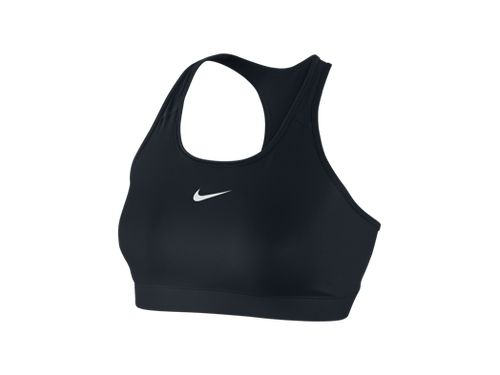 Nike Pro Core Sports Bra
Nike Pro Core Sports Bra
I’ve always used this sports bra. One is all I need and it’s great. Also, it doubles as a great swim top.
Teva Mush II Thong Sandals (5.3oz)
Cons: Wearing them with socks is a pain. I usually just slipped all my toes to the side of the thong when I needed to walk at camp.
 La Sportive Bushido (Men’s) Trail Running Shoe
La Sportive Bushido (Men’s) Trail Running ShoePros: Good grip and sole for the off trail high routes I was doing. Pretty much the only shoe I could find to fit my unique width with bunions. Men’s size seemed even wider.
Bottom line: I don’t recommend these unless you have a wide foot and Solomons or Altras don’t work for you.
Lynco L405 Sports Orthotic Insoles
I need some type of added support to hike the trail and another hiker told me about the Lynco Insoles. I am a neutral walker and tend to need something for the ball of my foot. These are very unique and I recommend using them for a good month before the trail if your feet are new to them. They have a lump under the upper part of the arch of your foot. There are other styles for different needs. The unique form takes some getting used to, but I found them to feel great and also relieve a lot of the pressure on the ball of my foot. Expensive, but totally worth the price for me. I would get a new pair every ~1000mi. It’s a matter of personal preference. I know these have helped some hikers with plantar fasciitis. I’ve always used them and never had foot issues.
Fizan Compact Trekking Poles (11oz)
Pros: It took me awhile to buy into the concept of twist lock poles, but these are great!!! I’ve put my poles through the ringer, and these have definitely passed the test. I also use them nightly for my tent poles.
Cons: I wish they had cork handles. The black material rubs off on my hands when my hands are damp or sweaty. Also, my old Black Diamond poles were ergonomically angled and I miss that. I don’t miss the heavier weight though! Difficult to find in the US, so try Massdrop.
White Sierra Teton Trail Convertible Pants
These are the only hiking pants I’ve ever used, but I may be changing…
Pros: The only pants I could find that weren’t form fitting and tight in the thighs. Yes, they are baggy on me, but I like that. I still have a pair I’ve worn at least 5yrs. It was nice to have the option of shorts or pants with the zip offs. They have lots of pockets for my gadgets and snacks.
Cons: The newer version of these pants (2 summers ago) were disappointing, lower quality, and fit differently. I’m hoping to buy new ones that were more like the previous version…
Smartwool Microweight Pajama Top/Bottom (5oz each)
It took me forever to buy these pricey pajamas, but they are perfect and saved me many ounces off what I was using before. The pants are slightly sheer and I’d only wear them in my tent. Both could be used in emergency for extra warmth. They tend to last 2 thru hikes before needing to be replaced.
Andiamo skins (unpadded) biker shorts(black)
Nice for added warmth and those who experience chafing. They were also great to wear for swimming. A suggestion from the maker is that if they are being used for hiking, cut off the tight elastic band on the thighs. My advise it to not cut them too high as they will ride up on the thighs if you do. I’ve always used these and they save me from a lot of chafing issues. Also great for swimming!
Dirty Girl Gaiters (1oz)
Pros: Love em! I recommend buying two pairs and switching halfway on long hikes. I once tried to go a week without them and I couldn’t stand all the debris that got in my shoes. Also, without them, my socks were quick to get holes in them. Just a fun company and unique patterns to fit everyone’s personality.
Cons: The adhesive for the velcro can wear off in sandy dusty conditions. I carried extra velcro that comes with the gaiters, but have not had to use it much. Using Shoo Goo or Gorilla Glue helps keep them on there.
GAIA GPS App
My phone has become my sole GPS these days, and GAIA is my go to app for navigation.
Pros: This is a really great one to use once you learn how to use it. It is used while the phone is offline. I found it to be quick and easy to both load and use once I learned the ropes. I soo prefer this to the GPS! It is colorful, user friendly, and time efficient in loading.
Cons: It can soak up phone battery quickly if used over an extended amount of time. It also can take up a lot of storage depending on how many maps and tracks you load. Only an issue if you have a phone with little extra storage space.
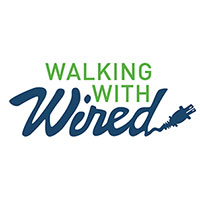
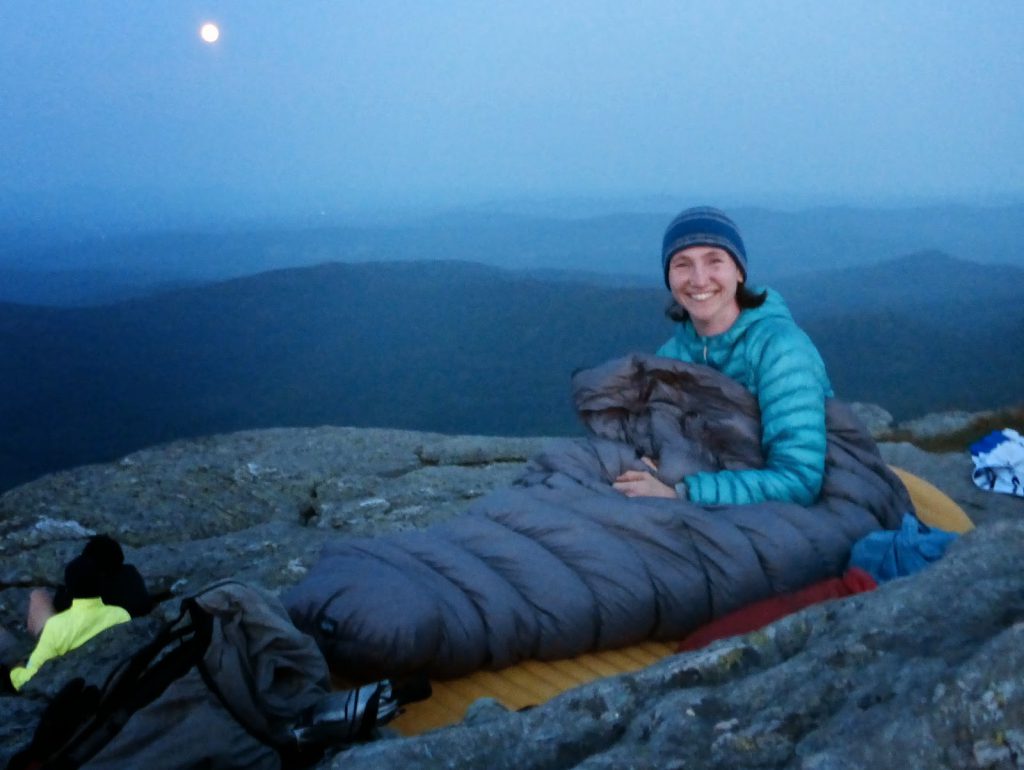


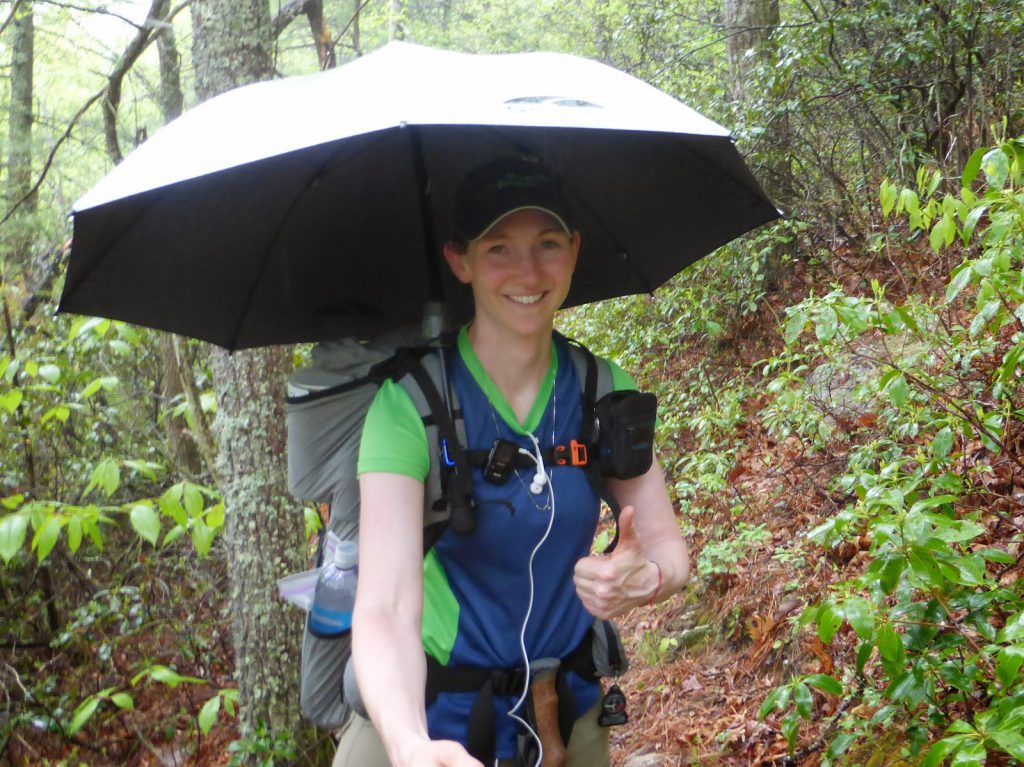
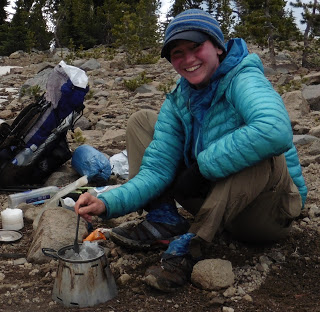
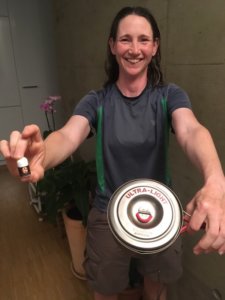

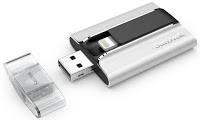

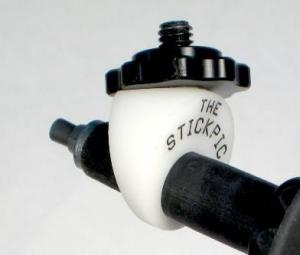
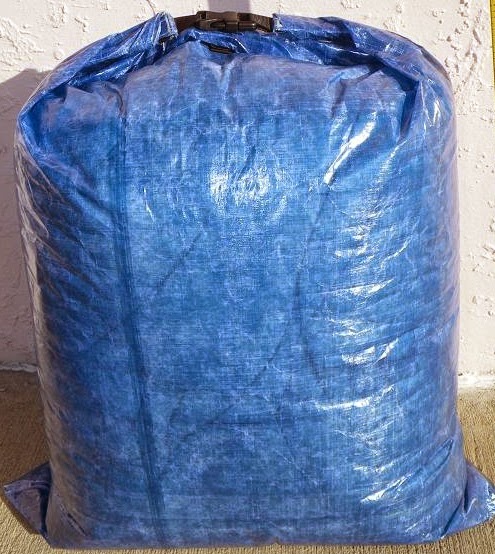

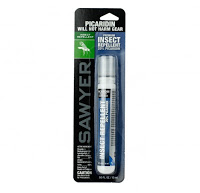
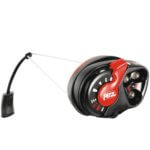
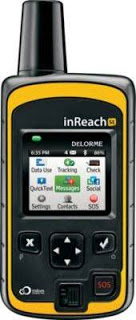
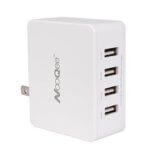
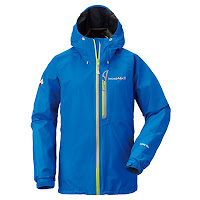

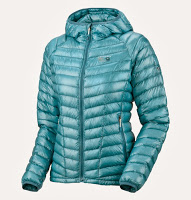
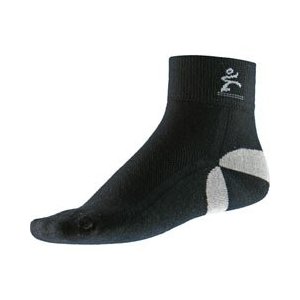
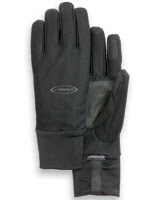
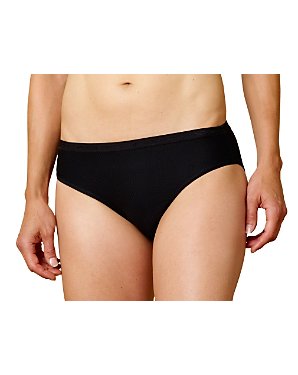

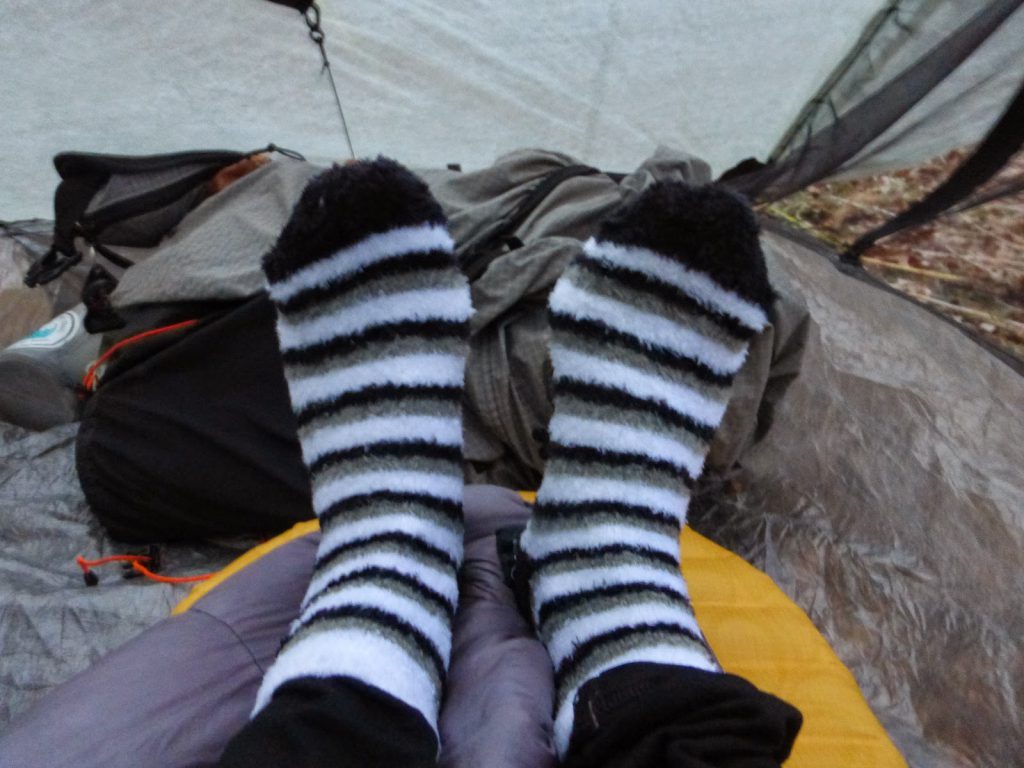
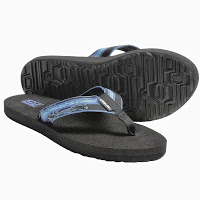
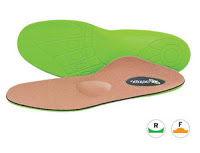
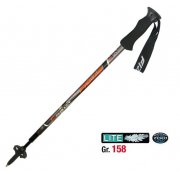
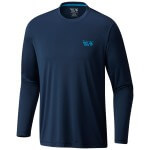
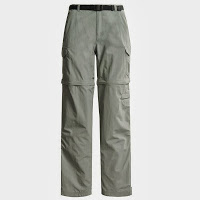

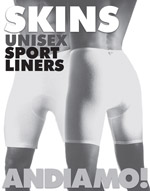

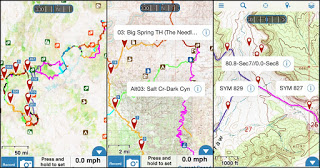



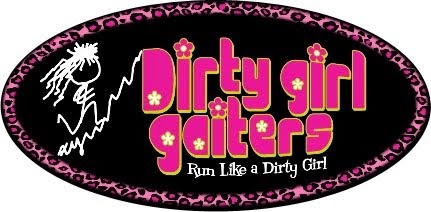




Geesh, I read the whoke thing even though I rarely bacoack these days! I learned a lot!
I would consider the mont bell storm cruiser jacket as a replacement rainshell
constructed from gore tex’s latest c knit material , ultra light, softer backer layer that is more flush with the main material than previous 3 layer rain shell backers
9oz
if you cant find your size in the statest you can also order from their japanese website
https://www.montbell.us/products/disp.php?cat_id=25013&p_id=2328148&gen_cd=2
Griggs went with their Peak Shell and is happy with it. However, in a very new development, I may take a stab at the ZPacks rain gear…TBD…
I hope zpacks raingear is more robust than it has been in the past
it delaminated in this review
http://maxneale.blogspot.co.nz/2015/11/zpacks-challenger-rain-jacket-and-pants.html
Good to see. I met someone using their rain gear this summer in the Pyrenees who was very happy with it. I’ll have to look into it and see what I think. Good news is that living in the Pacific Northwest, there’s no lack of rainy testing environments.
I hope you can persuade Zpacks to do women’s sizes. I have a men’s small which of course does not really fit at all, but I still use it. -Alane
Yes, that appears to be what they are coming out with this season thankfully.
in practice i’ve found three layer are better for breathability than two layer, two layer once moisture is smeared on the inside layer it cant breathe. in a three layer moisture is less likely to wet out the membrane as fast, allowing water vapour out. plus less likely to delaminate or damage the waterproof membrane.
I really enjoy your gear reviews and have gotten some great ideas from you. I’ve had a ZPacks 10F bag since 2013 and still use it a lot, but it just wasn’t warm enough for some of my trips, so I purchased Katabatic Gear 5F quilt and just love it. It’s the ultimate in cozy poofiness. I pair the ZPacks with a NeoAir Xlite pad for warmer trips and my Katabatic with an XTherm for colder trips.
It’s a real bonus to have access to reviews from other smallish sized women — thank you!
“Cozy Poofiness”, haha. That’s what I’m excited about! I also picked up an XTherm to take to Nepal this coming spring. Ready for the COLD!
Go-Lite is back in business, but is called My Trails. They have the Chrome Dome for sale, but out of stock until spring. Here’s a link to their website.
https://mytrailco.com/collections/accessories/products/chrome-umbrella?variant=20147776707
Ah, that’s right! I’ll edit that!
Everybody loves gear reviews! Don’t they?!
Merry Christmas.
Always love your gear reviews, but that knife doesn’t have a bottle opener! Also, you may want to checkout Lexar flash drives if you ever need to replace the SanDisk. I’ve used both on hikes and the Lexar had less issues watching shows.
Cool, good to know Burrban!
Well written, concise and informative as usual, Wired. You are both an amazing hiker and a great writer. Thank you for helping me make wise decisions about the gear I carry.
I am curious about your take on the fleece garments.. jackets? that you and Griggs bought last year in NZ. You seemed quite happy with yours, but not sure if it would become a permanent addition to your gear…
It cracks me up when someone who pays attention to detail (like you Lynn!) will notice where I slack off…I can’t get anything by you! This post is exhausting to write, but I knew I needed to do it. I knew I had left off that fleece we used the month we were in Tasmania (since it isn’t part of my usual gear) and was just too spent to add it on with the regular gear I carry. I love it, and will likely be carrying it in Nepal since it will be quite COLD there at times. For sure, I’ll be writing about it in my gear review next year since it will play a more prominent role:)
I am a detail person.. .. But I guessed wrong.. Fleeces were in Tasmania, not NZ.
I did realize the fleece was extra..
Yes, Nepal would be a good place for that extra layer..
Cold, plus altitude issues.
I am looking forward to Nepal, here in my living room, of course. ?
Great reviews and tips. Thanks!
That is a fine-tuned gear list! Thank you for sharing!
It seems like you have little issue with buying and replacing gear. Can you write about how you reconcile this type of high consumerism with the fact that buying stuff destroys wilderness? If everyone shopped like you, we’d need many, many planets to sustain us. There’s a deep irony here. I love to hike and understand the need for strong gear, but I haven’t yet figured out a way to buy new stuff each season and keep my values about the sacredness of the environment intact. How do you feel about this? I post this as someone seeking advice and input, not as someone trying to criticize you or others. I think this is a serious issue that, in my experience, few thru-hikers really give a shit about and it’s always confused me. How can someone buy tons of stuff AND value the integrity and majesty of wilderness?
It’s interesting that it comes off that way when it’s actually quite the opposite. I tend to use gear at least two years before it needs replacing and often try to stretch it to three. Some things even longer. I stretched my rain jacket for three years. I’m really cheap, so I won’t replace a piece of gear until it’s really worn out. The pants I wore this summer are the same ones I wore on my first thru-hike in 2011 and many hikes since then. I also bought my first new long sleeved shirt since 2014 this summer. It may seem like I’m buying new gear because this review is from a new set of gear I got after the 2015 season (I had my gear stolen in the mail when I sent most of it home that summer) and have been using since then, but am just now writing a review on after using it for two years (I was hiking last winter and missed a year on my gear review).
In the case that I’m given a new piece of gear as a gift through the blog, or from a sponsor, I find a way to pass the old gear on to someone else who would use it. When you really think about it, thru-hikers consume very little compared to daily life. Most people I know will use gear until it disintegrates. It’s interesting that you have this impression of thru hikers from the outside perspective. I actually feel very much the opposite way knowing how little I do consume.
High consumerism? Haha! You must live in the woods full-time Andrew.
Thru hikers consume way less than “ordinary” folk.
If you look at Wired’s gear reviews her basic pack weight has been 13 to 16 lbs. Hardly “tons of stuff” – she’d never step a pace with even one ton! Given thru hikers are not running a home or a car for months on end -wearing the same clothing every day, living frugally in every way – I would say they are the opposite of what you describe. Many are ambassadors for the wilderness and do a lot to protect it. Of course there will be exceptions to this. If you think about what you would consume at home versus what you will on your hike then maybe you can reconcile your conflict.
I’ve been using the Teva Mush flip flops for years as my camp shoes. My dedicated sleep socks are smart wool toe socks, so they work well with the flip flops.
Which Katabatic bag are you considering Wired? I was looking as well and it seems like we are gear soul sisters lol
I just got the Sawatch 15F and am guessing it’s comparable to the Zpacks 5-10F range. It will be interesting to see how I like the idea of a quilt though. Most nights I use tend to use my sleeping bag as a blanket, but wonder if I’ll miss that patch underneath when it’s truly COLD in Nepal. I am small enough to wrap it almost completely under me though. It will be interesting to see how I take to it. The do make sleeping bags that zip as well. I’m loving the visible quality and warmth so far.
Nice to see what gear stays from year to year. My forefront has become wider now and my regular insole left me with numb toe. Just wondering abuot the Lynco’s if you are buying the men’s for extra width or women’s to go with your shoes? Any thoughts on fit sizing up or down or as is. Thanks! 🙂
Do you have any idea how difficult it would be to get canister fuel along the HRP?
Hmm, I feel like every 2 wks or so you’d come across a grocery store that would have them. If you are on Facebook, there is a Pyrenean Haute Route fb group that’s new and run by the guy currently rewriting the guidebook. He would likely know the answer. https://www.facebook.com/groups/769512779917888/
Hello, Im doing Te Araroa this year starting South Island in November and tossing up between the Katabatic and the Zlite sleeping bags. Im a cold side sleeper – which of these would you recommend in retrospect?
BTW so very useful to have your trip notes and gear list – so very very helpful – thank you
Thanks for your answer in advance,
Taya
I think you mean Zpacks sleeping bag. Both bags are sufficient, but people say the Katabatic bags are more true to their rating (warmer). Also, the Katabatic bags do not have a zipper because they are quilts. Some people are worried about that factor, but I suggest you watch the videos Katabatic has on their site to reassure you that it’s just as warm as having a bag that zips. I wrote more about my preferences for the Katabatic bag here. Again, both are sufficient for the TA. https://walkingwithwired.com/2018/03/new-gear-for-the-great-himalaya-trail.html